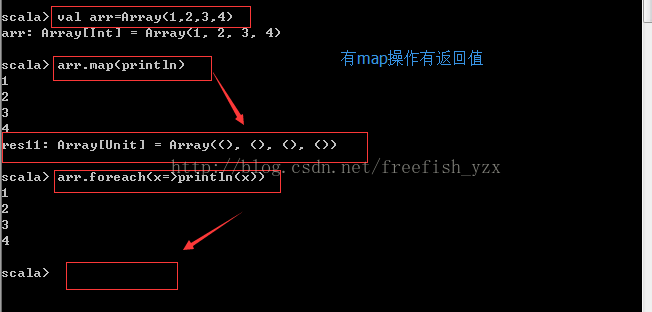object Hello_List {
def main(args: Array[String]): Unit = {
//创建一个List
val lst0 = List(1,7,9,8,0,3,5,4,6,2)
// 1.将lst0中每个元素乘以10后生成一个新的集合
val list1=lst0.map(_*10) //map是一个方法,里边传一个简化的函数
println(list1)
// 2.将lst0中的偶数取出来生成一个新的集合
val list2=lst0.filter(_%2==0) //符合条件的留下
println(list2)
// 3.将lst0排序后生成一个新的集合
val list3=lst0.sorted
println(list3)
// 4.反转顺序
val list4=lst0.sorted.reverse
println(list4)
// 5. 将lst0中的元素4个一组,类型为Iterator[List[Int]]
val list5=lst0.grouped(4)
println(list5)//list5是一个类型为Iterator[List[Int]]的迭代器 值为:non-empty iterator
/*
把一个迭代器执行toList时候就相当于把迭代器的指针指向末尾了
*/
//println(list5.toList) //List(List(1, 7, 9, 8), List(0, 3, 5, 4), List(6, 2))
println(list5.toList)
println(list5)//empty iterator
// 6.将Iterator转换成List
val list6=lst0.grouped(4)
println(list6.toList) //List(List(1, 7, 9, 8), List(0, 3, 5, 4), List(6, 2))
//7. map 和foreach区别
/*
map和foreach都是可以对每一个元素操作,但是map是对每一个元素操作完了还会返回一个新的集合
而foreach则不会返回任何值
*/
val arr=Array(1,2,3,4)
print(arr.map(println ))
print(arr.foreach(x=>println(x)))
//8.将List压平 意思是说List里边套着很多List,压平之后就剩下外边的一个List
//8.1首先准备一个list套list的数据结构
val list8=lst0.grouped(4)
println(list8) //non-empty iterator
val list8_1=list8.toList
println(list8_1) //List(List(1, 7, 9, 8), List(0, 3, 5, 4), List(6, 2))
//8.2压平
val list8_2=list8_1.flatten
println(list8_2) //List(1, 7, 9, 8, 0, 3, 5, 4, 6, 2)
//map是输出结果再保存到一个集合里边
//foreach是对每一个元素进行操作并输出
//将多个list压扁成一个List
val lines = List("hello tom hello jerry", "hello jerry", "hello kitty")
println(lines.flatMap(_.split(" ")))
//List(hello, tom, hello, jerry, hello, jerry, hello, kitty)
//flatMap中的_表示一行内容 hello tom hello jerry 一共有三行 即对每行操作
//flatMap(_.split(" ")) 中的_.split(" ") 就相当于"hello tom hello jerry".split(" ")
println(lines.flatMap(_.split(" ")).map((_ ,1)))
//List((hello,1), (tom,1), (hello,1), (jerry,1), (hello,1), (jerry,1), (hello,1), (kitty,1))
//返回的List集合,集合里边每一个元素为元组 访问元组的第一个元素为_._1
//例如:println((""hello",1)._1) 结果为hello
//lines.flatMap(_.split(" ")).map((_ ,1))中的map((_ ,1) _表示每一个单词,1表示每出现一次计数为1
println(lines.flatMap(_.split(" ")).map((_ ,1)).groupBy(_._1))
//Map(tom -> List((tom,1)), kitty -> List((kitty,1)), jerry -> List((jerry,1), (jerry,1)), hello -> List((hello,1), (hello,1), (hello,1), (hello,1)))
// lines.flatMap(_.split(" ")).map((_ ,1)).groupBy(_._1)中的groupBy(_._1)表示按照list中每个元组中的第一个字段分组即拿第一个字段作为key,返回结果是一个大Map
//groupBy(_._1)中的第一个_表示list中的每一个元组,而 ._1 表示取每一个元组中的第一个元素
println(lines.flatMap(_.split(" ")).map((_ ,1)).groupBy(_._1).mapValues(_.foldLeft(0)(_+_._2)))
//Map(tom -> 1, kitty -> 1, jerry -> 2, hello -> 4)
// lines.flatMap(_.split(" ")).map((_ ,1)).groupBy(_._1).mapValues()中的mapValues()仅仅会对value处理,处理完了把key 结合起来
// mapValues()中的第一个_表示map里边的value ,而value是一个list
//lines.flatMap(_.split(" ")).map((_ ,1)).groupBy(_._1).mapValues(_.foldLeft(0)(_+_._2)) 中的foldLeft(0)是给一个初始值
// (_+_._2)中的第一个_表示初始值或者累加过的值,第二个_表示List里边的元组,._2表示拿到元组中的第二个字段
println(lines.flatMap(_.split(" ")).map((_ ,1)).groupBy(_._1).mapValues(_.foldLeft(0)(_+_._2)).toList)
// List((tom,1), (kitty,1), (jerry,2), (hello,4))
// 转化为List
println(lines.flatMap(_.split(" ")).map((_ ,1)).groupBy(_._1).mapValues(_.foldLeft(0)(_+_._2)).toList.sortBy(_._2))
//List((tom,1), (kitty,1), (jerry,2), (hello,4))
//sortBy(_._2)中的第一个_ 表示每一个元组,第二个._2 每个元组中的第二个字段
println(lines.flatMap(_.split(" ")).map((_ ,1)).groupBy(_._1).mapValues(_.foldLeft(0)(_+_._2)).toList.sortBy(_._2).reverse)
//List((hello,4), (jerry,2), (kitty,1), (tom,1))
//reverse表示降序排序
//先按空格切分,在压平
//并行计算求和
println(lst0.par.sum)//45 并行求和
println(lst0.par.reduce(_+_))//45 并行求和
//lst0.par表示并行,根据CPU合数决定
//化简:reduce
//将非特定顺序的二元操作应用到所有元素
//安装特点的顺序
//折叠:有初始值(无特定顺序)
println(lst0.par.fold(0)(_+_)) //45
println(lst0.par.fold(10)(_+_))//125
//折叠:有初始值(有特定顺序)
println(lst0.foldLeft(0)(_+_))
//聚合 aggregate
val arr1 = List(List(1, 2, 3), List(3, 4, 5), List(2), List(0))
println(arr1.aggregate(0)(_+_.sum,_+_))// 先局部求和,在整体求和
val l1 = List(5,6,4,7)
val l2 = List(1,2,3,4)
//求并集
println(ll.union(l2))
//求交集
println(ll.intersect(l2))
//
//求差集
println(ll.diff(l2))
//println(r3)
/*val lines = List("hello tom hello jerry", "hello jerry", "hello kitty")
lines.flatMap(_.split(" ")).map((_, 1)).groupBy(_._1).mapValues(_.foldLeft(0)(_+_._2))
lines.flatMap(_.split(" ")).map((_, 1)).groupBy(_._1).map(t=>(t._1, t._2.size)).toList.sortBy(_._2).reverse*/
}
}
